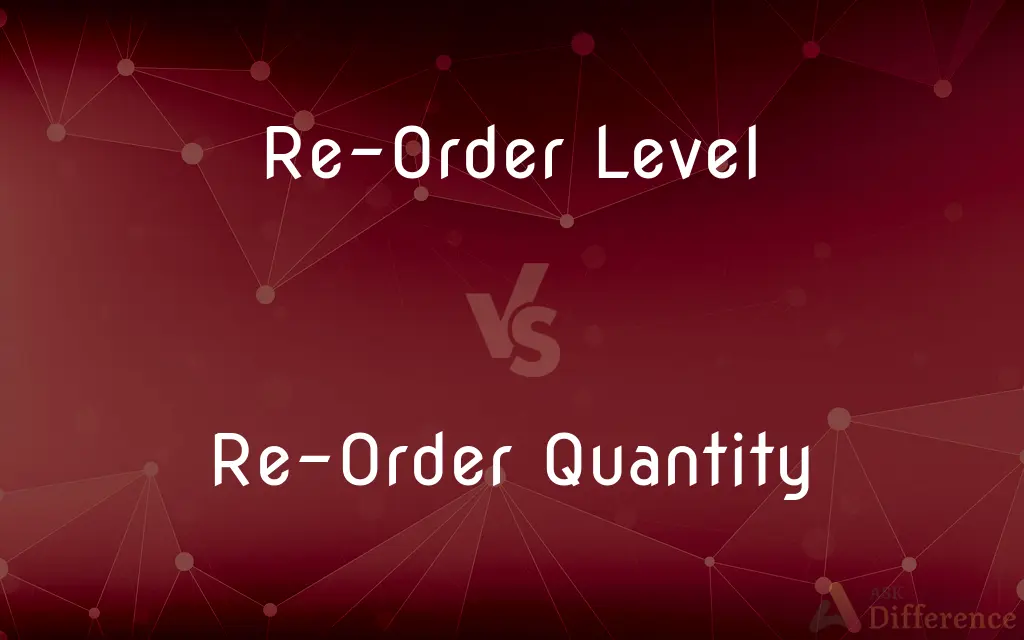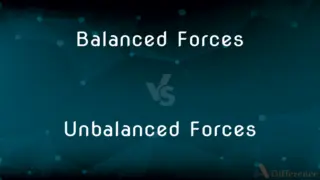Re-Order Level vs. Re-Order Quantity — What's the Difference?
Edited by Tayyaba Rehman — By Fiza Rafique — Published on December 25, 2023
Re-Order Level is when stock should be reordered; Re-Order Quantity is how much stock to order.

Difference Between Re-Order Level and Re-Order Quantity
Table of Contents
ADVERTISEMENT
Key Differences
Re-Order Level refers to the stock point at which an order should be placed for replenishment. This is calculated considering the lead time to receive goods and the usage rate. Re-Order Quantity, on the other hand, refers to the specific amount of stock that should be ordered when reaching the Re-Order Level.
Re-Order Level is instrumental in ensuring a smooth flow in operations without running out of necessary items. Re-Order Quantity ensures that when a reorder is triggered, the quantity received is optimal for storage and use.
In determining the Re-Order Level, businesses must consider factors like delivery time and consumption rate. Meanwhile, when setting the Re-Order Quantity, they might take into account bulk purchase discounts or storage limitations.
It's essential to note that while Re-Order Level triggers the need to make an order, the Re-Order Quantity determines the magnitude of that order. Both are crucial in inventory management to maintain efficiency and reduce costs.
If a business doesn't understand or improperly sets its Re-Order Level, it may face stockouts. In contrast, an incorrect Re-Order Quantity could lead to excess stock or insufficient stock, affecting operational efficiency.
ADVERTISEMENT
Comparison Chart
Definition
Point to reorder stock.
Amount of stock to be ordered.
Focus
Timing
Quantity
Based on
Lead time & usage rate.
Storage capacity & discounts.
Potential Risk
Stockouts
Overstock or understock.
Goal
Maintain stock continuity.
Optimize order size.
Compare with Definitions
Re-Order Level
The stock point triggering a reorder.
When inventory hits the Re-Order Level, it's time to place a new order.
Re-Order Quantity
A calculation considering storage and consumption.
Our warehouse can handle the current Re-Order Quantity comfortably.
Re-Order Level
The stock level indicating it's time for action.
As we approached the Re-Order Level, we prepared to contact our suppliers.
Re-Order Quantity
The amount of stock to order when replenishing.
We've determined the optimal Re-Order Quantity to maximize our discounts.
Re-Order Level
An inventory control method denoting replenishment time.
Keeping an eye on the Re-Order Level helps maintain continuous supply.
Re-Order Quantity
A strategy to maintain inventory without overstocking.
We adjusted our Re-Order Quantity after assessing monthly sales data.
Re-Order Level
A set threshold to prevent stockouts.
To ensure we never run out, we've set a Re-Order Level for each product.
Re-Order Quantity
The bulk of products ordered to sustain business operations.
Our Re-Order Quantity ensures we always have enough stock for two months.
Re-Order Level
A proactive approach to inventory management.
With a clear Re-Order Level, we avoid last-minute ordering scrambles.
Re-Order Quantity
The volume of items ordered upon hitting the reorder point.
By setting a fixed Re-Order Quantity, we ensure consistent stock levels.
Common Curiosities
Why is Re-Order Level important?
It helps prevent stockouts and ensures continuous supply.
How often should businesses review their Re-Order Level?
Regularly, especially if there are changes in consumption patterns or lead times.
Can the Re-Order Quantity be larger than the storage capacity?
No, it should be set considering storage limits and consumption rates.
Can Re-Order Quantity change frequently?
Ideally, it should be consistent but can be adjusted based on demand or storage changes.
Can a business operate without determining a Re-Order Quantity?
Yes, but it might face inefficiencies in stock management and costs.
How do seasonal businesses handle Re-Order Level and Re-Order Quantity?
They adjust them based on seasonal demand and storage capabilities.
Is there software to help determine the Re-Order Level and Re-Order Quantity?
Yes, many inventory management systems offer this feature.
How is Re-Order Quantity different from Re-Order Level?
Re-Order Level indicates when to order; Re-Order Quantity specifies how much to order.
What is the Re-Order Level?
Re-Order Level is the stock point at which a reorder should be placed.
Do both Re-Order Level and Re-Order Quantity impact cost?
Yes, both influence costs related to stockouts, storage, and bulk purchasing.
Can a business have a high Re-Order Level and low Re-Order Quantity?
Yes, it depends on their strategy, storage space, and supplier terms.
What factors affect setting the Re-Order Level?
Factors include lead time, consumption rate, and buffer stock.
Can Re-Order Level and Re-Order Quantity be the same?
Not typically. One denotes a point, the other a quantity.
Is it necessary for every business to have a Re-Order Level?
While not mandatory, it's recommended for efficient inventory management.
How do sudden market changes affect Re-Order Level and Re-Order Quantity?
Businesses may need to recalibrate both based on new market conditions.
Share Your Discovery

Previous Comparison
Balanced Forces vs. Unbalanced Forces
Next Comparison
Thiamine Mononitrate vs. Thiamine HydrochlorideAuthor Spotlight
Written by
Fiza RafiqueFiza Rafique is a skilled content writer at AskDifference.com, where she meticulously refines and enhances written pieces. Drawing from her vast editorial expertise, Fiza ensures clarity, accuracy, and precision in every article. Passionate about language, she continually seeks to elevate the quality of content for readers worldwide.
Edited by
Tayyaba RehmanTayyaba Rehman is a distinguished writer, currently serving as a primary contributor to askdifference.com. As a researcher in semantics and etymology, Tayyaba's passion for the complexity of languages and their distinctions has found a perfect home on the platform. Tayyaba delves into the intricacies of language, distinguishing between commonly confused words and phrases, thereby providing clarity for readers worldwide.











































